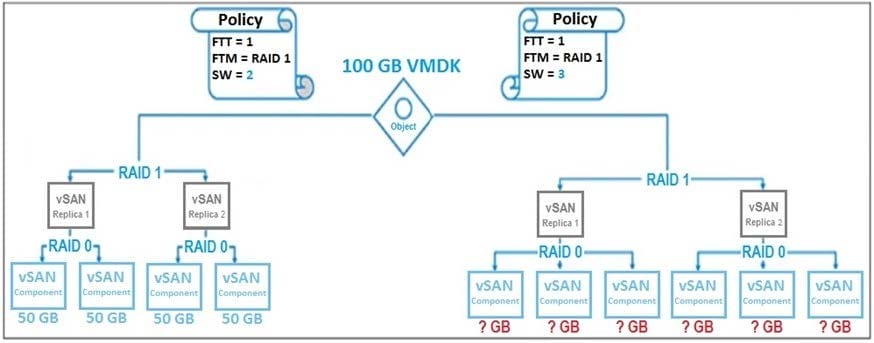5V0-21.19 Online Practice Questions and Answers
A storage administrator discovers vSAN is rebalancing components across a cluster randomly and faces
degraded performance on the applications.
What should be done to avoid these issues?
A. Size at least two disk groups on each node
B. Maintain a minimum of 10 percent unused capacity
C. Keep total storage consumption <70 percent
D. Ensure there is sufficient queue depth on the I/O Controller
A vSAN cluster has this configuration: -4 hosts with 1 disk group per host -Each disk group contains 1 cache device and 7 capacity devices
What are two ways to increase the vSAN datastore storage capacity? (Choose two.)
A. Add a host to the cluster
B. Add a cache device to each disk group
C. Add a capacity drive to each disk group
D. Replace a cache device with a larger cache device
E. Add a disk group to each host
Which VM file type resides in the VM home namespace object on a vSAN datastore?
A. .vswp
B. .vmsn
C. .vmx
D. .vmem
A system administrator running a 6-node cluster is trying to enable the deduplication and compression
feature. During the process of switching it on, the General vSAN error occurs.
What is the possible reason the General vSAN error occurred?
A. Force provisioning setting is required.
B. The cluster is a hybrid environment.
C. Storage policies require FTT=1.
D. The cluster is an all-flash environment.
Refer to the exhibit.

In a 2-node vSAN environment, a storage administrator has setup a vSAN storage policy.
When the stripe width is changed to three, what is the approximate component size of each replica marked
in red?
A. 33GB
B. 50GB
C. 66GB
D. 100GB
A host in a vSAN cluster has the following VMware Compatibility Guide approved disks: -3 solid state devices (SSD) used for cache -12 magnetic drivers (HDD) used for capacity
Which two options are valid disk group configurations? (Choose two.)
A. 1 Disk Group with 2 SSD and 6 HDD
B. 1 Disk Group with 3 SSD and 12 HDD
C. 2 Disk Groups with 1 SSD and 6 HDD each
D. 3 Disk Groups with 1 SSD and 4 HDD each
E. 4 Disk Groups with 3 HDD each
A vSAN all-flash environment with these host specifications has reported high network latency, write
latency, and faces degraded performance:
One 1Gbps (vSAN, vMotion Traffic)
One 1Gbps (Management, Fault Tolerance traffic)
Based on the specifications of each host, what is recommended to resolve the issue?
A. collapse all traffic into one 1Gbps NIC
B. collapse all traffic shared under two 10Gbps NICs
C. change stripe width to 12
D. change MTU to 9000
Refer to the exhibit.

A vSAN cluster has recently prompted an online health alarm.
What can the system administrator do to resolve the issue?
A. Disable Customer Experience Improvement Program feature.
B. Upgrade the ESXi host.
C. Suppress warning on the alarm.
D. Move VMs on affected host to other host(s).
Refer to the exhibit.

A storage policy has been created for the 3-node vSAN cluster in the exhibit. A VM is deployed using this policy.
What is the expected behavior?
A. VM will be deployed but remain non-compliant.
B. VM will be deployed and is reported compliant.
C. Force provisioning will be turned off automatically.
D. VM deployment fails.
vSAN Health shows a warning icon next to vSAN Disk Balance health check.
What can be done to fix this issue?
A. Click Repair Objects Immediately.
B. Reduce the maximum component size.
C. Enable Resynchronization Throttling.
D. Click Proactive Rebalance Disks.
